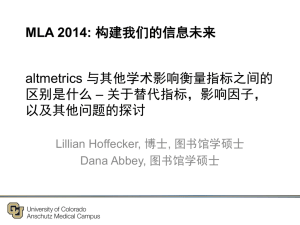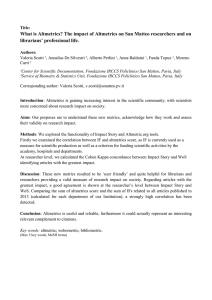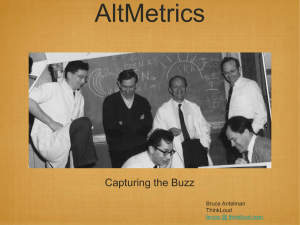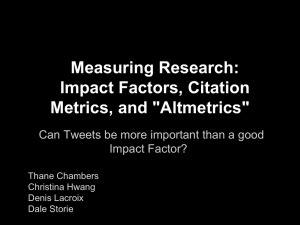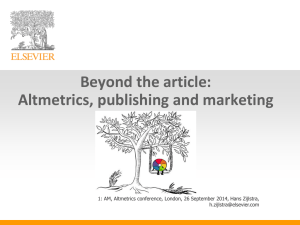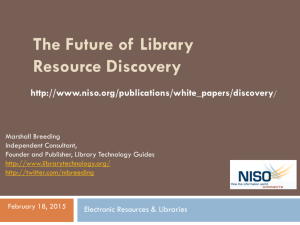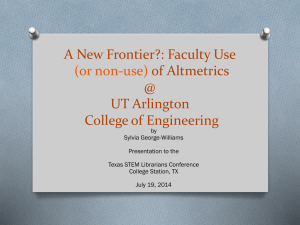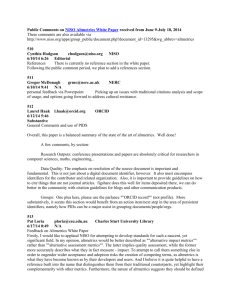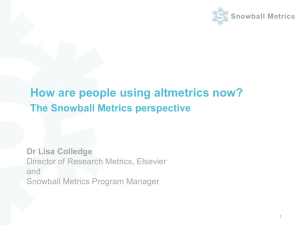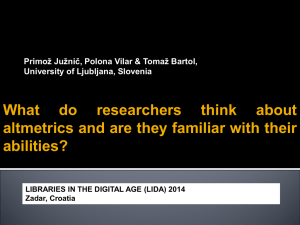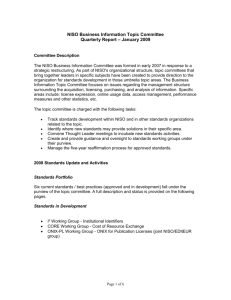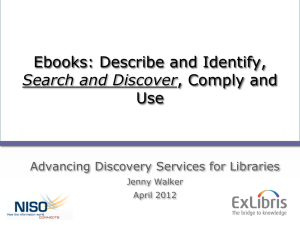slides - Altmetrics
advertisement
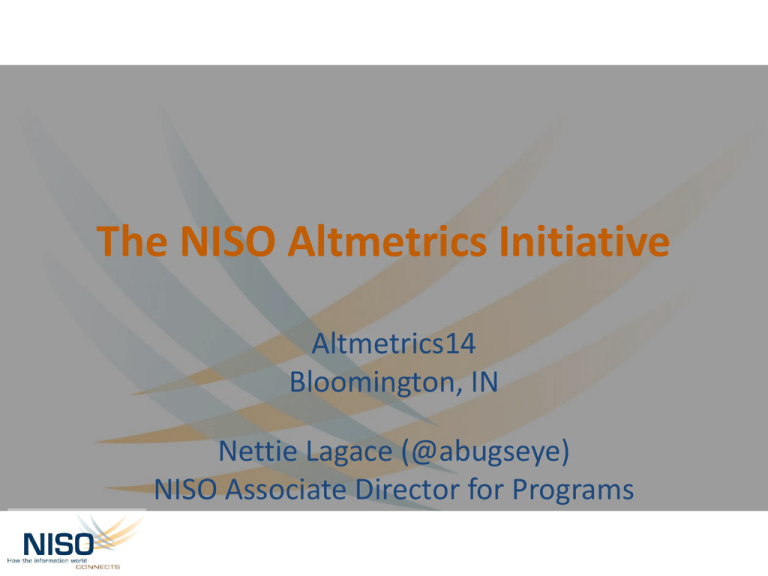
The NISO Altmetrics Initiative Altmetrics14 Bloomington, IN Nettie Lagace (@abugseye) NISO Associate Director for Programs What’s NISO? • Non-profit industry trade association accredited by ANSI with 150+ members • Mission of developing and maintaining standards related to information, documentation, discovery and distribution of published materials and media • Represent US interests to ISO TC46 (Information and Documentation) and also serve as Secretariat for ISO TC46/SC 9 (Identification and Description) • Responsible for standards like ISSN, DOI, Dublin Core metadata, DAISY digital talking books, OpenURL, SIP, NCIP, MARC records and ISBN (indirectly) • Volunteer driven organization: 400+ spread out across the world Premise of “Standards” • Consensus standards created by a community with various stakeholders • Trust • Leading to broader acceptance • • • • Standards as plumbing Standards facilitate trade, commerce and innovation Standards reduce costs Standards support better communication and interoperability across systems Definitions and Principles Standard Recommended Practice OA MI Balance: no single interest category constitutes a majority of the membership / voting pool / working group: producer, user, general interest Consensus: respond to all comments and make efforts to resolve negative votes, even if proposal is approved Open process: allowing members and the community to have confidence in NISO standards. 4 Why worth funding? • Scholarly assessment is critical to the overall process – Which projects get funded – Who gets promoted and tenure – Which publications are prominent • Assessment has been based on citation since the 60s • Today’s scholars multiple types of interactions with scholarly content are not reflected – Is “non-traditional” scholarly output important too? Why worth funding? • In order to move out of “pilot” and “proof-ofconcept” phases … • Altmetrics must coalesce around commonly understood definitions, calculations and data sharing practices • Altmetrics must be able to be audited • Organizations who want to apply metrics will need to understand them and ensure consistent application and meaning across the community 2 Phases – Phase 1 • Describe the current state of the altmetrics discussion • Identify potential action items for further work on best practices and standards • Hold meetings of stakeholders to define a high-level list of issues – – – – – October 2013, San Francisco December 2013, Washington, DC January 2014, Philadelphia Public Webinars White paper output, public presentations, public feedback 2 Phases - Phase 2 • Phase 2: Create Working Group within NISO structure, to create recommended practice(s) and/or standard(s) – Education/training efforts to ensure implementation • Final report to Sloan due November 2015 Steering Committee • • • • • • • • • • • • • • • Euan Adie, Altmetric Amy Brand, Harvard University Mike Buschman, Plum Analytics Todd Carpenter, NISO Martin Fenner, Public Library of Science (PLoS) (Chair) Michael Habib, Reed Elsevier Gregg Gordon, Social Science Research Network (SSRN) William Gunn, Mendeley Nettie Lagace, NISO Jamie Liu, American Chemical Society (ACS) Heather Piwowar, ImpactStory John Sack, HighWire Press Peter Shepherd, Project Counter Christine Stohn, Ex Libris Greg Tananbaum, SPARC (Scholarly Publishing & Academic Resources Coalition) Approach • Open format: lightning talks, brainstorming, breakout groups, etc. • Include all stakeholders • Focus on collecting unstructured input • Make all material (including audio recordings of steering group) publicly available Meeting Lightning Talks • Expectations of researchers • Exploring disciplinary differences in the use of social media in scholarly communication • Altmetrics as part of the services of a large university library system • Deriving altmetrics from annotation activity • Altmetrics for Institutional Repositories: Are the metadata ready? • Snowball Metrics: Global Standards for Institutional Benchmarking • International Standard Name Identifier • Altmetric.com, Plum Analytics, Mendeley reader survey • Twitter Inconsistency “Lightning" by snowpeak is licensed under CC BY 2.0 Discussions San Francisco Washington DC Philadelphia Business & Use Cases Business & Use Cases Use Cases (3X) Quality & Data science Qualitative vs. Quantitative Data Integrity Definitions Definitions/Defining Impact Definitions Development & Infrastructure Identifying Stakeholders and their Values Standards Future Proofing Interviews • Thirty researchers, administrators, librarians, funders (and others) • Semi-structured interview • March – April 2014 1. Develop specific definitions for alternative assessment metrics. 2. Agree on using the term altmetrics, or on using a different term. 3. Define subcategories for alternative assessment metrics, as needed. 4. Identify research output types that are applicable to the use of metrics. 5. Define appropriate metrics for specific output types. 6. Agree on main use cases for alternative assessment metrics. 7. Develop statement about role of alternative assessment metrics in research evaluation. 8. Identify specific scenarios for the use of altmetrics in research evaluation (e.g., research data, social impact). 9. Promote and facilitate use of persistent identifiers. 10. Research reproducibility issues. 11. Develop strategies to improve data quality. "Q is for Question Mark" by b4b2 is licensed under CC BY 2.0 12. Develop strategies to increase trust, e.g., openly available data, audits, or a clearinghouse. 13. Identify best practices for grouping and aggregating multiple data sources. 14. Identify best practices for grouping and aggregation by journal, author, institution, and funder. 15. Define contributorship roles. 16. Establish context and normalization over time, by discipline and country. 17. Describe main use cases for the different stakeholder groups. 18. Identify best practices for identifying contributor categories (e.g., scholars vs. general public). 19. Identify organizations to include in further discussions. 20. Identify existing standards to include in further discussions. 21. Prioritize further activities. 22. Clarify researcher strategy (e.g., driven by researcher uptake vs. mandates by funders and institutions). "Q is for Question Mark" by b4b2 is licensed under CC BY 2.0 http://www.niso.org Next steps • Finalize and release white paper and draft new work item proposal for standards/best practices based on the study • Proposal vetted by NISO leadership and members • Proposal approved and working groups formed for Phase II of the project Thank you! Questions? Nettie Lagace nlagace@niso.org @abugseye
